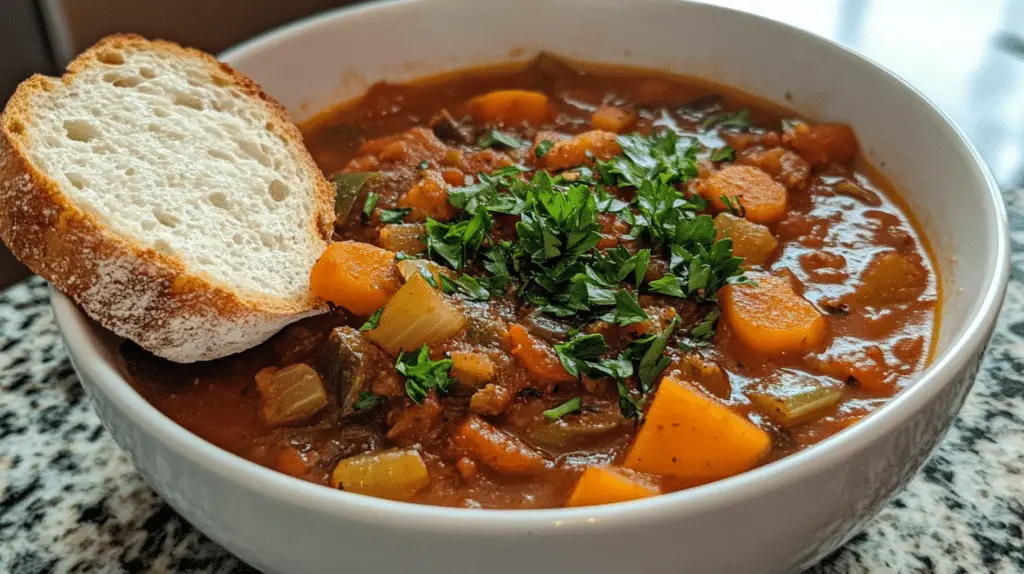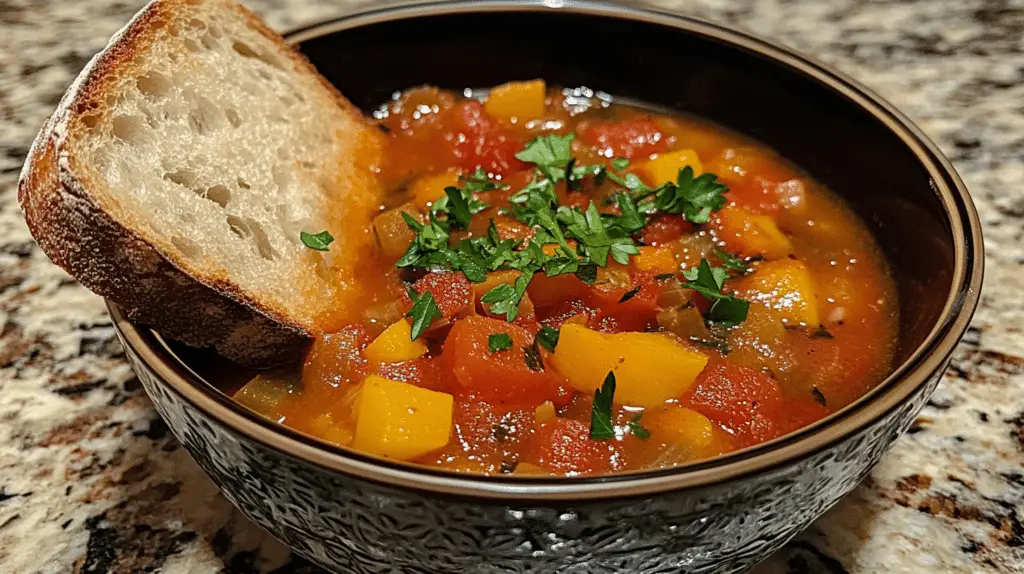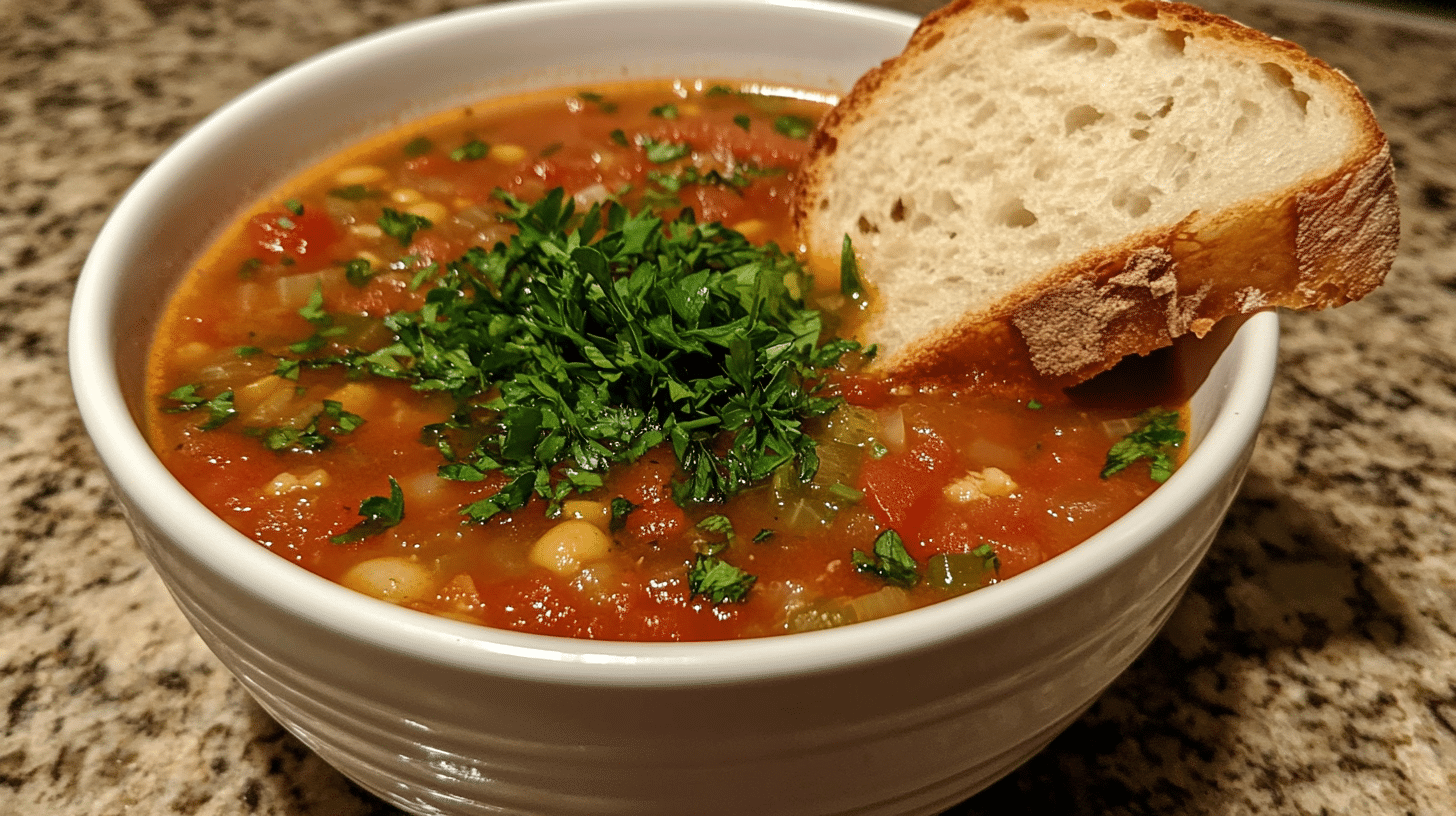Vegetable soup is a classic comfort food, but getting the right flavor can be tricky. If you’ve wondered what makes vegetable soup taste better, the secret is using the right ingredients and easy techniques.
Why Focus on Flavor?
- Health Benefits: A flavorful vegetable soup encourages healthier eating habits by making vegetables more enjoyable.
- Versatility: Whether for a light appetizer or a hearty main course, vegetable soup suits any occasion.
- Customizable: Experimenting with different seasonings and add-ins ensures every bowl is unique.
This guide explores tips and techniques to transform your vegetable soup into a flavorful, satisfying dish that everyone will enjoy.
Table of contents
The Basics of Vegetable Soup
Making a tasty vegetable soup begins with a solid foundation. Using fresh ingredients and simple methods helps create a flavorful base for a delicious dish.
Essential Ingredients for the Base
- Classic Aromatics: Carrots, onions, celery, and garlic are essential for building flavor.
- Stock or Broth: Use vegetable stock for a rich, vegetarian option or chicken broth for added depth.
- Seasonings: Salt, pepper, and bay leaves lay the groundwork for balanced seasoning.
Fresh vs. Frozen Vegetables
- Fresh Vegetables: Offer vibrant flavors and textures. Perfect for seasonal soups.
- Frozen Vegetables: A convenient option when fresh produce isn’t available, still retaining essential nutrients.
For a similar hearty option, explore this recipe for Old-Fashioned Vegetable Beef Soup to understand how to enhance a soup’s base.
Techniques to Make Vegetable Soup Taste Better
Simple techniques can turn a basic vegetable soup into a flavorful and unforgettable dish. Focusing on these methods ensures your soup is both rich and satisfying.
Sautéing Vegetables
- Cook aromatics like onions, celery, and carrots in olive oil or butter before adding liquid.
- Sautéing releases natural sugars, creating a sweet and savory flavor base.
Layering Spices and Herbs
- Combine dried and fresh herbs, like thyme and parsley, for a well-rounded flavor.
- Add bay leaves during simmering, then finish with fresh herbs for brightness.
Umami Enhancers
- Include ingredients like mushrooms, soy sauce, or nutritional yeast to deepen the flavor.
- Adding a Parmesan rind to the pot during cooking infuses the broth with a savory richness.
Balancing with Acidity
- A splash of vinegar or a squeeze of lemon juice brightens the soup and balances heavier flavors.
For another idea on infusing depth into meals, check out this guide on How to Make the Perfect Oatmeal Bowl, which offers tips on balancing flavors.
These techniques ensure your vegetable soup is packed with flavor and depth, making every spoonful satisfying and hearty.

Creative Ingredient Additions for Better Vegetable Soup
Using creative ingredients can make your vegetable soup even better, turning it into a tasty and hearty meal. Here are some ideas to enhance its flavor and texture.
Adding Grains and Legumes to Make Vegetable Soup Taste Great
- Barley: Adds a chewy texture and nutty flavor, making the soup more filling.
- Quinoa: A protein-packed grain that complements vegetables beautifully.
- Lentils or Beans: Add heartiness and boost protein for a more substantial meal.
Unique Vegetables
- Roasted Red Peppers: Introduce a smoky sweetness that pairs well with earthy vegetables.
- Sweet Corn: Adds a hint of sweetness and bright pops of color.
- Diced Tomatoes: Enhance the broth with acidity and a slight tang.
Greens for Freshness
- Kale: Sturdy and nutrient-rich, it holds up well in soups.
- Spinach: A quick-cooking green that blends seamlessly with other ingredients.
- Swiss Chard: Offers a mild, slightly bitter flavor for balance.
Spices and Aromatics
- Smoked Paprika: Infuses the soup with a subtle smokiness.
- Cumin: Adds warmth and depth, especially in soups with a tomato base.
- Fresh Ginger: Brightens the flavor and pairs well with root vegetables.
Protein Boosters
- Shredded Chicken: A great addition for a non-vegetarian version.
- Egg Drops: Swirl beaten eggs into the hot broth for added texture and protein.
Finishing Touches
- A drizzle of olive oil or a sprinkle of fresh herbs like parsley or dill adds a burst of flavor before serving.
- Top with grated Parmesan or crumbled feta for richness.
These additions ensure your vegetable soup is not only delicious but also packed with layers of flavor and texture, making it a satisfying and versatile meal.
Common Mistakes to Avoid When Making Vegetable Soup
Although vegetable soup is simple and healthy, some common mistakes can impact its flavor and texture. Steering clear of these issues ensures your soup is tasty every time.
Using Bland Stock or Broth
- The broth forms the foundation of the soup, so using a low-quality or flavorless option can lead to a dull taste.
- Choose rich, homemade stock or high-quality store-bought broth for the best results.
Prevent Overcooking for Great Vegetable Soup Texture
Cooking vegetables for too long can make them mushy and lose their unique textures.
- Add firmer vegetables like carrots and potatoes early in the cooking process.
- Save delicate ones like spinach or zucchini for the end to keep them fresh and tender.
Skipping the Sautéing Step
- Directly adding raw vegetables to the broth can leave the soup lacking in depth.
- Sautéing aromatics like onions, garlic, and celery before adding liquids releases their natural sweetness and boosts flavor.
Underseasoning
- Seasoning only at the end can result in an unbalanced flavor.
- Add salt and spices gradually throughout the cooking process, tasting as you go.
Not Layering Spices
- Adding all spices at once can flatten the flavor profile.
- Start with foundational spices like garlic and bay leaves, then build with additional herbs and seasonings as the soup cooks.
Skipping Acidity
- Without an acidic element like lemon juice or vinegar, the soup can taste flat.
- A splash of acidity brightens the flavors and balances the richness of the broth.
Neglecting the Finishing Touch
- Serving the soup without toppings or garnishes can miss the opportunity to add fresh flavors.
- Finish with herbs, grated cheese, or a drizzle of olive oil for an extra layer of taste.
Avoiding these common mistakes ensures your vegetable soup will always be flavorful, balanced, and satisfying.
Toppings and Side Pairings to Complement Vegetable Soup
The right toppings and sides can turn a basic bowl of vegetable soup into a filling and balanced meal. These additions boost flavor, texture, and visual appeal.
Toppings and Sides to Pair with Vegetable Soup
Herbs
- Add chopped parsley, cilantro, or dill for a fresh flavor.
- Use fresh basil for a fragrant touch, especially in tomato-based soups.
Cheese
- Sprinkle grated Parmesan or shredded cheddar for a rich, savory taste.
- Crumbled feta adds a tangy contrast to sweeter vegetables.
Crunchy Elements
- Top with homemade croutons for a crunchy texture.
- Try roasted nuts or seeds, like sunflower or pumpkin, for extra crunch.
Drizzles
- A swirl of olive oil or cream gives a smooth, rich finish.
- Add balsamic glaze for a touch of sweetness and tang.
Perfect Side Pairings
Bread
- Pair with crusty bread, garlic toast, or a warm baguette for dipping.
- Cornbread or sourdough works well for a hearty addition to the soup.
Salads
- Serve with a green salad dressed in a simple vinaigrette.
- A citrus or fruit salad adds a fresh and light contrast.
Grain-Based Sides
- Quinoa or couscous can be served on the side or mixed into the soup for extra texture.
- Wild rice provides a nutty flavor and chewy texture, complementing broth-based soups.
Creative Ideas
- Soup and Sandwich Combo: Pair your vegetable soup with a grilled cheese or a panini for a classic comfort meal.
- Stuffed Vegetables: Serve the soup with stuffed bell peppers or mushrooms for a unique presentation.
By incorporating these toppings and side dishes, you can elevate the experience of enjoying vegetable soup, turning it into a satisfying and memorable meal.

FAQs About Vegetable Soup
Here are answers to some common questions about vegetable soup to help you perfect your recipe:
What Is the Secret Ingredient in Soup?
- The “secret ingredient” varies by recipe, but common choices include vinegar, a Parmesan rind, or a small amount of soy sauce.
- These ingredients add flavor and balance to the soup.
How Do You Add Flavor to Vegetable Soup?
- Sauté vegetables to bring out their natural sweetness.
- Add ingredients like mushrooms, nutritional yeast, or Worcestershire sauce for a richer taste.
- A small amount of lemon juice or vinegar at the end can brighten the flavors.
Is Worcestershire Sauce Good in Soups?
- Yes, Worcestershire sauce adds a savory flavor to soups.
- Use it in small amounts to keep the taste balanced.
Why Does My Vegetable Soup Lack Flavor?
- This often happens when the broth is too bland or the vegetables are not sautéed first.
- Use good-quality stock and season gradually as you cook. Including umami-rich ingredients like mushrooms or soy sauce can enhance the flavor.
What Are the Best Herbs to Use in Vegetable Soup?
- Classic Options: Bay leaves, thyme, and parsley are versatile and blend well.
- Bright Additions: Cilantro and dill can add freshness at the end.
- Bold Choices: Basil and oregano pair beautifully with tomato-based soups.
Can I Freeze Vegetable Soup?
- Yes, most vegetable soups freeze well. Allow the soup to cool, then store it in airtight containers or freezer bags for up to 3 months.
- Avoid adding delicate greens or dairy until reheating to maintain texture and flavor.
How Do I Thicken Vegetable Soup Without Cream?
- Pureeing: Blend a portion of the soup and mix it back in for a thicker texture.
- Adding Starch: Stir in a small amount of mashed potatoes, cornstarch, or flour.
- Incorporating Grains: Use barley, rice, or lentils to naturally thicken the soup.
Final Tips for Making the Best Vegetable Soup
aking great vegetable soup is easy with a few simple tips. These strategies will help make your soup flavorful, hearty, and enjoyable.
Use Seasonal Vegetables
- Seasonal produce is fresher and more flavorful, making your soup taste better.
- Experiment with ingredients like butternut squash in the fall or zucchini in the summer.
Taste and Adjust as You Cook
- Regularly taste the soup throughout the cooking process to adjust seasoning.
- Add small amounts of salt, spices, or acid as needed for balance.
Experiment with Flavor Combinations
- Mix sweet vegetables like carrots and sweet potatoes with tangy or bitter ones like tomatoes and kale.
- Use spices like cumin or smoked paprika for unique flavor profiles.
Plan for Leftovers
- Vegetable soup often tastes better the next day as flavors meld.
- Store in the refrigerator for up to 5 days, or freeze for longer storage.
With these FAQs and tips, you’re equipped to make a delicious bowl of vegetable soup every time, tailored to your preferences and occasion.

